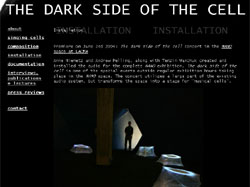| Technology makes art from sounds inside cells |
 |
 |
 |
Nanotechnology – the science of very, very small objects and processes
– is an important area of current research, and is now contributing to
art too. (A nanometre is a millionth of a millimetre and nanotechnology
deals with technology at this scale.)
This area of science is already producing some amazing inventions. These include, for example:
- Clothes that clean themselves
- Cosmetics that can pass through outer layers of skin to deliver substances like vitamins to cells under the skin
- Materials that are lighter and stronger than any previously known substance
Research in nanotechnology has given rise to a range of new tools
for scientists to see and control what is happening at the nanometre
scale. In biology, nanotechnology allows scientists to work in new ways
with the building blocks of life, cells.
Sounds
 Now
breakthroughs in the laboratory have been turned into art. The Dark
Side Of The Cell (DSC) is an audiovisual artwork that makes use of the
sounds from inside living cells. Now
breakthroughs in the laboratory have been turned into art. The Dark
Side Of The Cell (DSC) is an audiovisual artwork that makes use of the
sounds from inside living cells.
It was only in 2002 that Professor James Gimzewski and Andrew
Pelling discovered that yeast cells vibrate at the nanoscale. Working
at the chemistry department of the University of California, Los
Angeles (UCLA), amplified the vibration (or oscillation) of the cells
and brought them into range of human hearing.
"Sonocytology" is the name that has been given to this new area of
study. The main tool for learning about cell sounds is the atomic force
microscope (AFM). Instead of using optics to show an image, the AFM
uses a very fine tip to feel a cell in the same way a needle was used
to feel the pattern of vibrations that was pressed into old-fashioned
records.
Composition
The cell oscillation can be manipulated using chemicals. As the DSC
website explains: "Isopropanol (rubbing alcohol) for example, will
change a 'singing cell' into a 'screaming cell'. And a chemical such as
sodium azide will kill the cell, causing the emitted frequency to die
away, leaving only noise."
Nano-scientist Andrew Pelling has teamed up with artists Anne
Niemetz to create DSC, which is reportedly the first composition to use
cell sonics. The full artwork involves playing the cell-based
compositions in a darkened space that includes sculputures and
projections of microscopic images of the cells used.
The DSC was performed and exhibited at the Los Angeles County Museum
of Art. Afterwards, it was set up as a sound installation at the UCLA
department of Design|Media Arts. People who cannot get to California,
however, can experience a lot of the wonder of singing cells on the DSC
website.
Learn More:
Read more on The Dark Side Of The Cell
More nanotechnology art at Los Angeles County Museum of Art
Find out how one Dublin company works with nanocrystallites
Visit the Irish Nanotechnology Association
<< back

|

